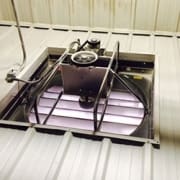The Americraft sales team frequently receives inquiries from customers wanting to purchase a variable frequency drive (VFD’s) for a fan application. Once we have a better understanding of air requirements and the environment in which the fan will operate, we will work with the motor manufacturer to identify the correct motor and VFD that will allow the fan to run efficiently.
I did some research to identify the most relevant information about motors and VFD’s for use in fan applications. This information is not intended to be technical by any means, but more to provide general information to help our customers think through the design process and consider all aspects of the environment in which the fan will operate.
65% of Industrial Electrical Energy is consumed by the electric motor.
An interesting statistic worth sharing is the fact that more than 65% of industrial electrical energy consumed is a result of the electric motors. Governments around the world are encouraging the more effective use of motors with variable speed drives. In the past, VFD’s were not a top choice because they were expensive and cumbersome in terms of size. It could take years to realize a decent return on investment. More common are the use of
dampers, inlet vanes and two-speed motors to control air flow in ventilation systems, but they are not all energy efficient.
Fortunately today, advances in technology have driven down the cost and size of VDF’s, thereby realizing a return on investment in a matter of months in most cases.
Basic Questions You Need to Answer Before Purchasing a VFD
If you are interested in controlling air flow and boosting energy efficiency,
contact us and we will help you select the best fan, motor and VFD to meet your needs. Before you make the call, here are some basic questions you should be able to answer with regard to the motor, electrical system and environment in which the fan will operate:
| Motor Requirements: |
Electrical System: |
Environment: |
| Motor Voltage |
Voltage |
Dripping Water? |
| HP or kW |
Frequency |
Oil? |
| Motor Rated FLA (amps) |
Phase |
Airborne dust? |
| Distance between drive and motor (feet) |
|
Wash-down? |
|
|
Other? |
Motors Operating on Variable Frequency Drives (VFD’s)
Today, most standard NEMA Premium Efficiency motors are designed with characteristics that enable use with VFD’s on variable torque loads such as the majority of fan applications. These motors will be labeled as either
“Inverter Ready” or
“Inverter Rated”, depending upon the motor manufacturer.
There are motors rated as
“Inverter Duty”, which are designed specifically for use with VFD’s and have all of the characteristics of premium efficiency motors along with larger frames or external
blowers to cool the motor regardless of its speed. There may be situations where an “inverter duty” motor is desired for a fan application, but it’s usually not required.
Single Phase Motors and VFD’s
We get a lot of questions from customers wanting to use a single phase motor with a VFD. This is not possible because of the starting mechanism used in most single phase capacitor start motors. The starting mechanism is not built to withstand changes in speed and will fail.
VFD’s convert Single Phase Input to 3-Phase Output
It’s important to understand the voltage requirements in which the motor and VFD will operate. For example, if your facility has 115V, single phase electric, most VFD’s will operate a 3-phase motor up to 1 ½ HP. If your facility has 230V, single phase electric, most VFD’s will operate a 3-phase motor up to 3HP. Higher horsepower motors are also a possibility, depending upon the application and the VFD used.
Contact us and we will work with the motor/VFD manufacturer to size the motor and VFD appropriately to meet your voltage requirements.




